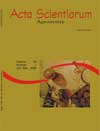<b>Damage, make-decision system, control of <em>Pseudophilothrips</em> sp. (Thysanoptera: Phlaeothripidae), and its relationship with fungic lesions on guava fruits</b> - DOI: 10.4025/actasciagron.v25i1.2675
Abstract
This work aimed to study the damage, make-decision system, control of Pseudophilothrips sp. (Thysanoptera: Phlaeothripidae) and its relationship with fungic lesions on guava fruits. The thrips Pseudophilothrips sp (Thysanoptera: Phlaeothripidae) and the fungi Collethotricum gloesporiodes and Pestalotia sp were observed on fruits with lesions. The number of lesions/fruit increased in function of the numbers of nymphs and adults of thrips/fruit. The most effective insecticides were carbaryl, cypermethrin, dichlorvos, ethion, fenpropathrin, fenitrothion, fention, lambdacyhalothrin, metamidofos, methyl parathion, permethrin, triclorfon, and vamidothion. The thrips sampling should be done by evaluation of the percentage of young attacked fruit (1.5 to 3 cm of diameter) by nymphs and adults of thrips. The sampling plan should be composed by evaluation of four fruits/plant on nine plants/field. The average of the economic thresholds for red guava cultivars were 0.70% (tractor insecticide application) and 1.82% (conventional knapsack sprayer) of infested guava fruits. The average of economic thresholds for white guava cultivars were 1.15% (tractor insecticide application) and 2.96% (conventional knapsack sprayer) of fruits with Pseudophilothrips sp.Downloads
Download data is not yet available.
Published
2008-04-23
How to Cite
Picanço, M. C., Crespo, A. L. B., Ecole, C. C., Bandji, C. A., Costa, H., & Couto, F. A. D. (2008). <b>Damage, make-decision system, control of <em>Pseudophilothrips</em> sp. (Thysanoptera: Phlaeothripidae), and its relationship with fungic lesions on guava fruits</b> - DOI: 10.4025/actasciagron.v25i1.2675. Acta Scientiarum. Agronomy, 25(1), 223-230. https://doi.org/10.4025/actasciagron.v25i1.2675
Issue
Section
Agronomy
DECLARATION OF ORIGINALITY AND COPYRIGHTS
I Declare that current article is original and has not been submitted for publication, in part or in whole, to any other national or international journal.
The copyrights belong exclusively to the authors. Published content is licensed under Creative Commons Attribution 4.0 (CC BY 4.0) guidelines, which allows sharing (copy and distribution of the material in any medium or format) and adaptation (remix, transform, and build upon the material) for any purpose, even commercially, under the terms of attribution.
2.0
2019CiteScore
60th percentile
Powered by 

2.0
2019CiteScore
60th percentile
Powered by 



















































